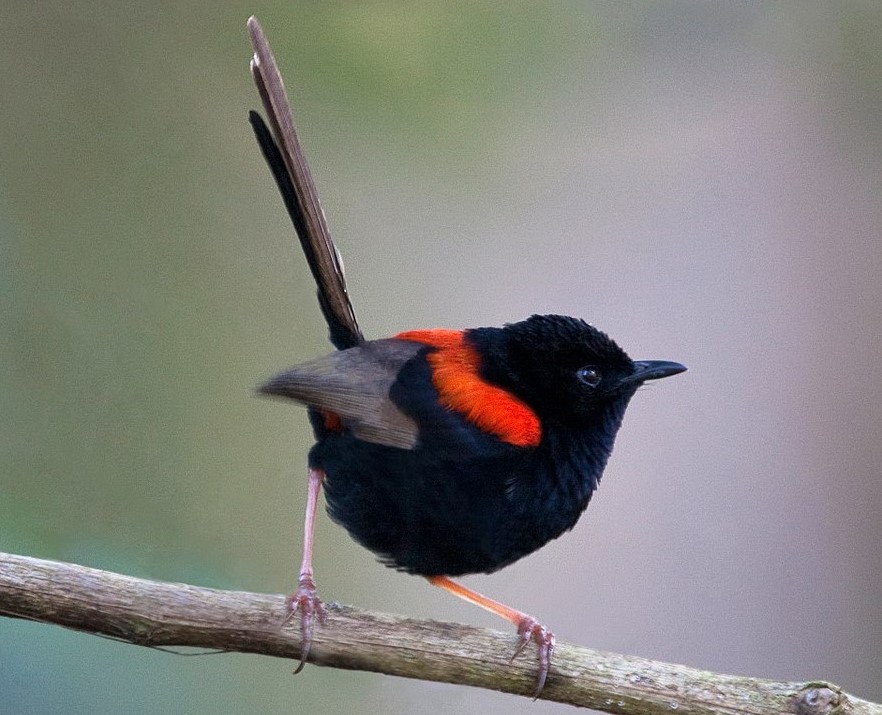FAMILY: The red-backed fairywren (Malurus melanocephalus) belongs to the Maluridae family of Australasian wrens.
HABITAT: Except for old black-winged birds, male Red-backed fairywrens change from red-and-black breeding finery to red-and-black breeding finery with the seasons. Red feathers are spread across their wings during territorial disputes, almost reaching the belly. Heathland and savannah are preferred habitats, particularly where low shrubs and tall grasses provide cover.
In areas where bushfires occur frequently, the bird may be nomadic, but in other parts of its range, it maintains and defends territories year-round. Male Chestnut-shouldered Fairy-wrens and White-winged Fairy-wrens court females by carrying red petals, contrary to yellow petals carried by Chestnut-shouldered Fairy-wrens.
BEHAVIOUR: Birds live in loose flocks of 15-30, breaking up into pairs for breeding and later gathering in small groups. During early morning and evening, Red-backed Fairy-wrens forage actively in their northern and eastern grassland habitat, hopping cock-tailed along the ground. During times when birds are not foraging, they often shelter together. Preening is done jointly by the two birds while they roost side-by-side in dense cover.
DIET: This species of fairywren eats mostly insects and seeds and small fruits as a supplement to its diet. In common with other fairywrens, the red-backed fairywren is primarily insectivorous; it consumes a wide variety of insects including beetles including leaf beetles, jewel beetles, flea beetles, grasshoppers, moths, wasps, and cicadas. Aside from spiders, larvae, and eggs of insects are also consumed.

OTHER NAMES: it is also known as Black-headed Wren and Orange-backed Wren.
LENGTH: The size is between 100mm and 130mm.
IDENTIFICATION: Males of the species have orange to crimson saddles over their backs. A grey-brown color is often found on the wings. The eyes are brown. The bill is black in color. Pale brown is the color of the feet. Non-breeding females have shorter tails than males.
FEMALE: Brown above, cream-white below; Lords have a whitish brown color; bill is red-brown.
IMMATURES: Like females, but bullier and with longer tails.
SOUND: A soft lisp call is carried out, tssst, in contact. It is known as an alarm call when bubbled churrs are heard.
SONG: The red-backed fairywren song is a soft, short, rippling warble, without an introductory chirp.
NESTING & BREEDING: Breeding and nesting take place from August to March, later in the north. The nest is a grass dome low in a grass clump or small bush. When a male breeds, he may remain in non-breeding plumage. As a sexually promiscuous species, the red-backed fairywren pairs with other individuals and even assists in raising their young. Young birds are fed by both adults and helper birds. Only the female incubates the eggs for two weeks. One week after hatching, the nestlings are hidden under cover. For approximately one month, juveniles are dependent on their parents and helpers.
EGGS: There are three to four eggs laid by the bird, which are white with small red-brown spots at the larger end. About 16 x 12 mm in size, these eggs are oblong-oval in shape.
DISTRIBUTION: Northern and eastern mainland rainfall savanna grasslands are a good place to find it in summer. Throughout the northern and eastern coasts of Australia, from the Kimberley in the northwest to the Hunter Region in New South Wales, it can be found near rivers and coastal areas. Most commonly seen in the morning and late afternoon, it hunts for insects in leaf litter, shrubbery, and on the edge of bodies of water.
PREDATORS: Mammals such as feral cats and red foxes, reptiles like goannas and rodents, and native predatory birds like the Australian magpie, butcher bird species, blue-winged kookaburras, crows and ravens, and shrike-thrushes can prey on adults and their young. Females and males of the red-backed fairywren may display rodent-run displays to deter predators from nests with young birds
SUBSPECIES: There are two races: one across the north and one across the east. The long-tailed M. m. cruentatus inhabits northern Australia, and the short-tailed M. m. melanocephalus inhabits eastern Australia. Read More – Splendid Fairy-wren (Malurus splendens)
